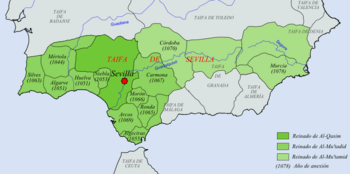Taifa of Seville facts for kids
Quick facts for kids
Taifa of Seville
|
|||||||||
|---|---|---|---|---|---|---|---|---|---|
| 1023–1091 | |||||||||

The Kingdom of Seville at its greatest extent in green, c. 1080
|
|||||||||
| Capital | Seville | ||||||||
| Common languages | Arabic, Berber, Mozarabic, Hebrew | ||||||||
| Religion | Islam, Roman Catholicism, Judaism | ||||||||
| Government | Monarchy | ||||||||
| Historical era | Middle Ages | ||||||||
|
• Downfall of Caliphate of Córdoba
|
1023 | ||||||||
|
• Death of last king Al-Mu'tamid and defeat after Almoravid troops
|
1091 | ||||||||
| Currency | Dirham and Dinar | ||||||||
|
|||||||||
| Today part of | Spain Portugal Gibraltar |
||||||||
The Taifa of Seville (pronounced Tie-fah of Seh-veel) was an Arab kingdom that existed a long time ago. It was ruled by the Abbadid family. This kingdom was formed in 1023 and lasted until 1091. It was located in what is now southern Spain and Portugal.
The Taifa of Seville became independent after the Caliphate of Córdoba fell apart. It grew quite a bit in the mid-1000s. Later, a powerful Christian kingdom called Castile became a threat. Seville asked for help from the Almoravids, who were from North Africa. The Almoravids helped, but then they took over Seville themselves.
Contents
History of the Taifa of Seville
A taifa was a small Muslim kingdom in what is now Spain and Portugal. The Taifa of Seville started as a small area. It included parts of modern Spanish provinces like Seville, Huelva, and Cádiz. But it quickly grew to become the strongest taifa of its time. Its rulers had a plan to expand their territory.
Early Rulers and Expansion
The first ruler of Seville was Abu al-Qasim. He ruled from 1023 to 1042. He was a qadi (a judge) in Seville. When the Caliphate of Córdoba collapsed in 1031, he declared Seville independent. He became known as Abbad I, the emir (ruler) of Seville.
His son, Abbad II al-Mu'tadid, took over in 1042 and ruled until 1069. He continued to expand the taifa. During his time, Seville conquered several other smaller taifas. These included Mertola, Niebla, Saltés and Huelva, Silves, and Santa María de Algarve.
Seville's Golden Age and Fall
Abbad II's son, Muhammad al-Mu'tamid, ruled from 1069 to 1091. He made Seville a very important center for culture in the Muslim world. He captured the city of Córdoba in 1071. He held onto Córdoba for most of his rule, even though it was sometimes difficult. His vizier (a high-ranking official) and fellow poet, Ibn Ammar, also conquered the city of Murcia.
However, the Abbadid rulers felt unsafe. The Christian kingdom of Castile was becoming very strong. King Alfonso VI of Castile had many military successes. He captured Toledo in 1085, which was a big blow to the Muslim kingdoms.
Al-Mu'tamid asked for help from the Almoravids. They were a powerful group from what is now Morocco. The Almoravids came to fight against the Castilians. They set up their base in Algeciras. After defeating the Christians at the Battle of Sagrajas in 1086, the Almoravids started taking over the other Muslim taifas.
In 1091, they occupied Seville itself. The Almoravids then controlled large parts of what is now Spain. After they attacked Seville, al-Mu'tamid told his sons to give up the royal fortress. This was to save their lives. He was taken prisoner to Aghmat and died there in 1095.
Many artists and writers came to Seville during this time. Poets like Ibn al-Abbâr and Abû 'Âmir ibn Maslama moved to the court. Their works were collected by Abû'l-Walîd al-Himyarî.
Culture in the Taifa of Seville
The city of Seville was known for making beautiful pottery. This pottery was called lusterware. It was made from the late 1000s. Many pieces of this pottery have been found. They show designs similar to other ceramics made in the Taifa of Seville. Some pieces even have names of two Abbadid princes of Seville. This shows that the rulers supported these pottery workshops for many years.
Symbols of the Taifa
Old stories say that the Almoravids fought under a white flag. But the soldiers from Andalusia, like Emir Al-Mu'tamid, used different green flags. These flags had Islamic writings on them. This is believed to be the origin of the current flag of Andalusia. It is now used as the flag for the autonomous region and is called Arbonaida.
See also
 In Spanish: Taifa de Sevilla para niños
In Spanish: Taifa de Sevilla para niños
- Al-Andalus
- History of Islam
- History of Spain
- List of Sunni Muslim dynasties

